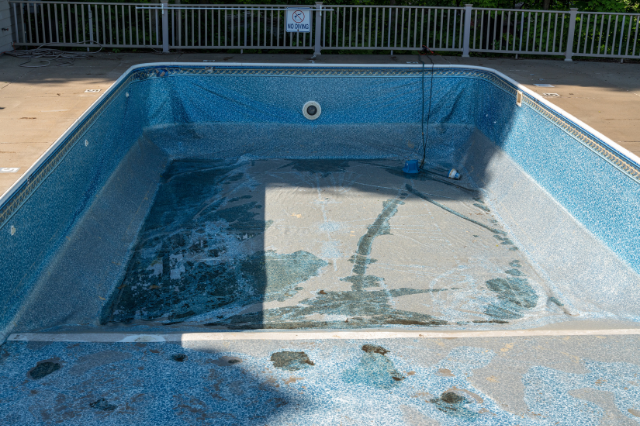A pool is a haven during the hot summer months, but noticing a drop in water level can be a cause for concern. While some water loss is normal due to evaporation, sudden or significant drops may signal a leak. Understanding how to determine if your pool has a leak and addressing the issue promptly can prevent costly repairs and wasted water. Here’s a guide to help you determine if your pool is leaking and what steps you can take to fix it.
Understanding Natural Water Loss: How Much Evaporation Is Normal?
Evaporation is a natural process, and even a well-maintained pool will lose some water daily. On average, a pool without a cover can lose about a quarter-inch of water per day, especially during hot weather. Pools with heating systems, water features, or no covering lose water at a faster rate due to increased exposure to heat and air circulation. If you have a heated pool or one with waterfalls or fountains, it’s important to monitor the water levels closely. Installing a pool cover or enclosure can slow down evaporation and reduce water loss.
However, if water loss appears excessive, especially during cooler seasons when evaporation rates are lower, this could indicate a leak rather than natural evaporation.
Key Factors that Increase Pool Evaporation
Several factors can impact the rate at which your pool loses water to evaporation. High temperatures, low humidity, and strong winds are the primary contributors. Pools exposed to the sun without any shade or tree cover will evaporate faster than pools with some shelter. Seasonal changes also play a role—evaporation tends to increase in summer and decrease in cooler months.
If you observe unusual water loss during colder months or after periods of stable weather, it’s a good idea to investigate for leaks.
Common Causes of Pool Leaks
While pools are designed to be watertight, various issues can lead to leaks over time. Here are some of the common causes:
- Deteriorated Seals and Linings: Over time, seals around lights, skimmers, and returns can degrade and allow water to escape.
- Plumbing Issues: Pool plumbing, especially in-ground systems, can develop leaks due to corrosion, cracks, or loose fittings.
- Structural Cracks: Temperature changes, soil shifts, or settling can cause cracks in the concrete or pool walls, allowing water to leak out.
- Equipment Malfunction: Filters, pumps, and heaters also have seals and connections that can deteriorate, creating leakage points.
How to Identify a Pool Leak
If you suspect your pool is losing more water than usual, look for additional signs of leakage, such as:
-
Wet Spots or Damp Soil: Check around the pool area, especially near the equipment pad, for unusually wet or mushy ground. Excessive moisture in these areas can signal a leak.
-
Cracked Concrete or Tiles: Cracks in the pool deck, tiles, or surrounding concrete can indicate shifting that might have caused a structural leak.
-
Unbalanced Chemicals: If your pool’s chemical levels are hard to maintain, it may be due to a constant influx of water from a leak diluting the pool’s chemistry.
Testing for a Pool Leak: The Bucket Test
The bucket test is a simple and effective way to determine if water loss is due to evaporation or a leak. Here’s how to perform the test:
- Fill your pool to its normal water level.
- Place a bucket on the first or second step of your pool so it is partially submerged.
- Fill the bucket with pool water to about an inch from the top.
- Mark the water level inside the bucket and the pool’s water level on the outside of the bucket.
- Wait 24 hours, ensuring the pool is unused and there’s no rain.
- Compare the water levels. If the pool water level has dropped significantly more than the water in the bucket, there’s likely a leak.
Locating the Leak: The Dye Test
If the bucket test confirms a leak, you can use the dye test to pinpoint the location. This method works well if you have an idea of where the leak might be.
- Add a few drops of dye or food coloring around the suspected area with the pool filled to its normal level.
- Observe the movement of the dye. It will naturally flow toward any cracks or openings where water is escaping.
- For underwater leaks, you may need goggles to get a closer look at the pool’s bottom or sides to follow the dye’s path.
Repairing the Leak
Once you’ve located the leak, repairs may vary depending on its cause and location:
- Sealants: For minor leaks around lights, returns, or fittings, pool-specific sealants are often effective.
- Epoxy for Cracks: If the leak stems from cracks in concrete or tiles, an epoxy repair kit may be able to seal the crack temporarily.
- Professional Repair: Larger or more complex leaks, especially those in plumbing or the pool’s foundation, will require a professional. Experienced pool repair specialists have the tools to address the issue efficiently and ensure the repair holds over time.
Regular Maintenance: The Key to a Leak-Free Pool
Routine pool maintenance helps prevent leaks by addressing wear and tear before it becomes a problem. Regularly inspect and clean all seals, filters, pumps, and other equipment. Monitoring your pool’s water level can also help you detect unusual drops early on, making it easier to repair leaks before they worsen.
By identifying and repairing leaks promptly, you can extend the life of your pool, enjoy uninterrupted pool days, and save money on water and maintenance costs.




